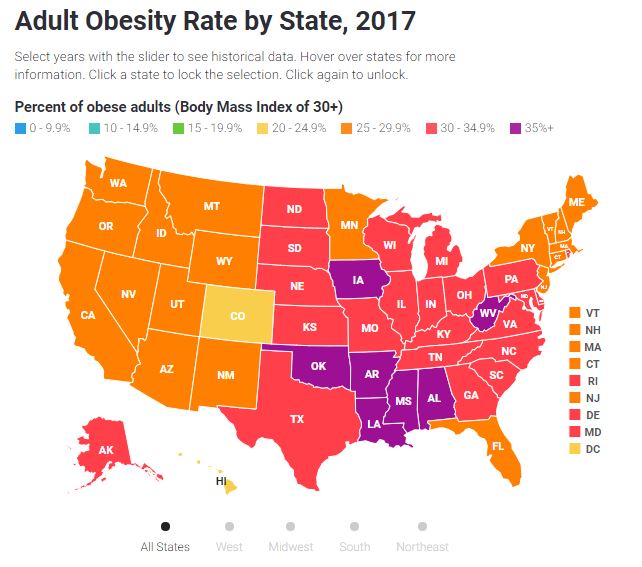
Share On Social!
Adult obesity rates reached 35% in at least 7 states and saw increases in 31 states across the U.S. from 2012-2017, while no significant drops in obesity rates were seen in any state, over the last year.
These are the latest findings from a report from the Trust for America’s Health and The Robert Wood Johnson Foundation.
The report developed using data from the CDC’s Behavioral Risk Factor Surveillance Survey (BRFSS) goes on to highlight how adult obesity continued to rise in at least 6 states: Iowa, Massachusetts, Ohio, Oklahoma, Rhode Island, and South Carolina, between 2016-2017.
In the case of Iowa and Oklahoma, this is the first time these states reach the 35% obesity threshold.

The states with the highest levels of obesity by rank are:
- #1- West Virginia (38.1%)
- #2- Mississippi (37.3%)
- #3- Oklahoma (36.5%)
- #4- Iowa (36.4%)
- #5- Alabama (36.3%)
- #6- Louisiana (36.2%)
- #7- Arkansas (35.0%)
To provide more context to the gravity of these rising rates, it is important to realize that no states had obesity rates of over 35%, prior to 2012.
Does Obesity Affect All Populations Equally?
Certain populations such as Latinos, African American, and those living in rural communities or low income households are likely to experience obesity at higher levels.
These differences are often the result of environmental factors such as having less access to healthier options and fewer opportunities to be physically active, among other potential stressors such as: fewer opportunities for early childhood education, higher educational attainment, access to affordable housing, and adverse childhood experiences (ACEs), encountered by those living in underserved communities.
Inequities in health and high obesity rates are especially problematic for Latino adults who experience higher levels of obesity compared to other race/ethnicity groups. Currently, 47% of Latino adults are obese vs. 46.8% of African Americans, and 37.9% of whites.
Rural areas are also greatly affected by high obesity rates, with a national adult obesity rate of 34.2% in rural communities vs. 28.7% in metropolitan areas according to data from .
How Can We Prevent Obesity Rates from Rising?
In order to be effective in reducing state level obesity rates we must see local, state and federal level governments take action. Along with implementing policies and programs that can serve to create healthier environments it is important to prioritize those populations at greatest risk of obesity.
“Obesity is a complex problem, so solving it will require evidence-based, multi-sector approaches,” said John Auerbach, President and CEO of Trust for America’s Health. “There is a growing body of evidence that policies and programs that align efforts across sectors—among health departments, transportation officials, schools, and businesses—can work.”
Some examples of important policy actions recommended in the report to promote a healthy weight include:
- Maintain nutrition standards for school meals that were in effect prior to USDA’s interim final rule from November 2017, as well as current nutrition standards for school snacks.
- States should ensure that all students receive at least 60 minutes of physical education or activity during each school day.
- Food and beverage companies should eliminate children’s exposure to advertising and marketing of unhealthy products.
Access the full 15th annual State of Obesity: Better Policies for a Healthier America report here.
Also, learn more about the policies to promote a healthy weight and overall health for Latino and all communities on the Salud America! website.
By The Numbers
25.1
percent
of Latinos remain without health insurance coverage



